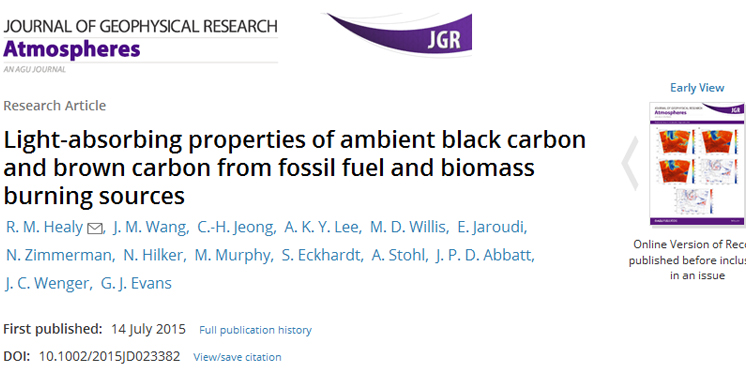In This Section
New Publication in Journal of Geophysical Research

Publication on CHEMBC Project
An atricle has been published in the Journal of Geophysical Research (Atmospheres) based on work by Dr. Robert Healy as part of the CHEMBC Project.
R. M. Healy, J. M. Wang, C.-H. Jeong, A. K. Y. Lee, M. D. Willis, E. Jaroudi, N. Zimmerman, N. Hilker, M. Murphy, S. Eckhardt, A. Stohl, J. P. D. Abbatt, J. C. Wenger and G. J. Evans.
Abstract
The optical properties of ambient black carbon-containing particles and the composition of their associated coatings were investigated at a downtown site in Toronto, Canada, for 2 weeks in June 2013. The objective was to assess the relationship between black carbon (BC) coating composition/thickness and absorption. The site was influenced by emissions from local vehicular traffic, wildfires in Quebec, and transboundary fossil fuel combustion emissions in the United States. Mass concentrations of BC and associated nonrefractory coatings were measured using a soot particle–aerosol mass spectrometer (SP-AMS), while aerosol absorption and scattering were measured using a photoacoustic soot spectrometer (PASS). Absorption enhancement was investigated both by comparing ambient and thermally denuded PASS absorption data and by relating absorption data to BC mass concentrations measured using the SP-AMS. Minimal absorption enhancement attributable to lensing at 781 nm was observed for BC using both approaches. However, brown carbon was detected when the site was influenced by wildfire emissions originating in Quebec. BC coating to core mass ratios were highest during this period (~7), and while direct absorption by brown carbon resulted in an absorption enhancement at 405 nm (>2.0), no enhancement attributable to lensing at 781 nm was observed. The efficiency of BC coating removal in the denuder decreased substantially when wildfire-related organics were present and may represent an obstacle for future similar studies. These findings indicate that BC absorption enhancement due to lensing is minimal for downtown Toronto, and potentially other urban locations, even when impacted by long-range transport events.
Other Links:
- Full List of CRAC Publications
Centre for Research into Atmospheric Chemistry
Ionad Taighde Um Ceimice Atmaisféarach
Contact us
Lab B1, Kane Building, University College Cork, T12 YN60.
